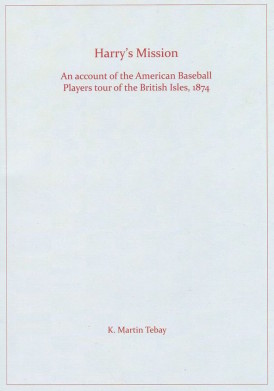Harry’s Mission
Martin Chandler |Published: 2019
Pages: 28
Author: Tebay, K Martin
Publisher: Red Rose Books
Rating: 3.5 stars

Over the years I have read, to say the least, quite a few cricket books. A large number of those have been on the subject of overseas tours, and not always by national teams. There are many such visits in respect of which a detailed account has so far eluded me, but it is unusual to find a book with a subject matter that is about something that, on it’s face*, appears to be completely new to me.
Harry’s Mission is about an 1874 tour of the UK by a team of 23 professional baseball players from Philadelphia and Boston, led by the Sheffield born Harry Wright. The party arrived at the end of July and left again at the end of August. In the meantime they played exhibition baseball games and a total of seven cricket matches. None of the matches were First Class, if for no other reason than the Americans fielded 18 players in each of them (except against All-Ireland, when they played 19). The hosts fielded 11 or 12.
One of the matches was against a Manchester XI, and although Tebay does give an account of the trip as a whole he, entirely appropriately for a Lancashire cricket historian, concentrates on that match. The Americans won the game, as they did their matches against Prince’s Club, Sheffield and All-Ireland. Surrey, Sheffield and the MCC drew, so the visitors went through their trip unbeaten.
When the tour took place the first Test match was still three years away. The only international fixture that had ever been played was between the USA and Canada, first contested in 1844 and on several occasions subsequently. Even so only a handful of these Americans had played cricket before, including Harry Wright and two of his brothers. The general consensus seems to have been that the Americans were much more proficient as cricketers than the English cricketers who took part in some of the baseball exhibitions were at the American game.
The baseballers were, it must be conceded, top players and professional sportsmen. The cricketers they faced were rather less gifted, so perhaps the results were not unexpected. They certainly weren’t poor opposition however. In the Manchester game seven of the hosts played First Class cricket, although none of them would ever play at Test level. By far the best known cricketer the Americans encountered was Alec Watson. In a long career (which was at an early stage in 1874) Watson played more than 300 First Class matches. Most were for Lancashire but he did play once for the Players against the Gentlemen at Lord’s, in those days the most prestigious fixture in the cricket calendar.
By using contemporary reports Tebay has done a fine job of reconstructing the game in Manchester, and of looking at the tour as a whole. The crowds do not seem to have flocked to the matches though, and there is no suggestion the tour was a financial success. In any event hindsight tells us that baseball has never caught on in England, and that save in Philadelphia, and then only for twenty or thirty years, cricket never became popular in the USA.
The catalyst for the appearance of the booklet, other than Tebay’s interest in any cricket played in Lancashire in times gone by, would seem to be the recent matches that took place at the London Stadium between the New York Yankees and the Boston Red Sox and the result of which, I suppose, might be to create the interest in this country in baseball that the 1874 visit failed to do.
Harry’s Mission appears in a card bound limited edition of 100 copies available at £7.99 including postage via the publisher’s website.
*In fact I eventually realised I had read about Harry’s Mission before, albeit fairly briefly. The book concerned is Beth Hise’s 2010 published Swinging Away: How Cricket and Baseball Connect.






Leave a comment